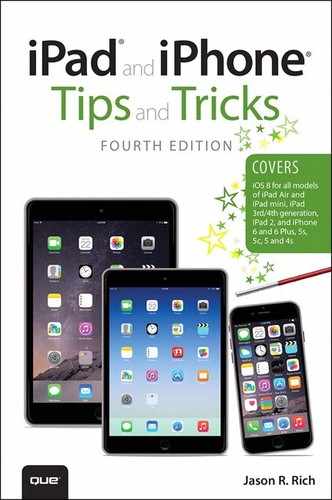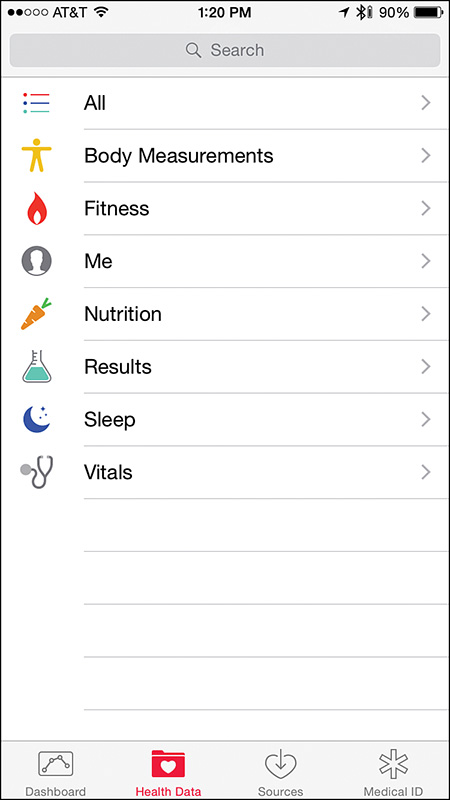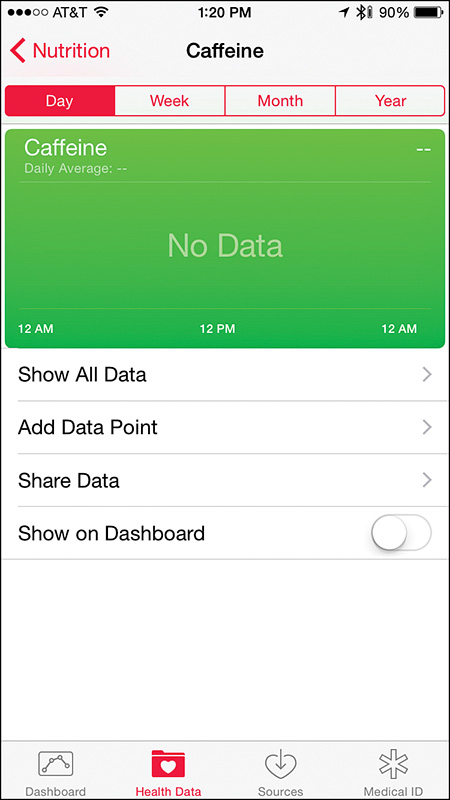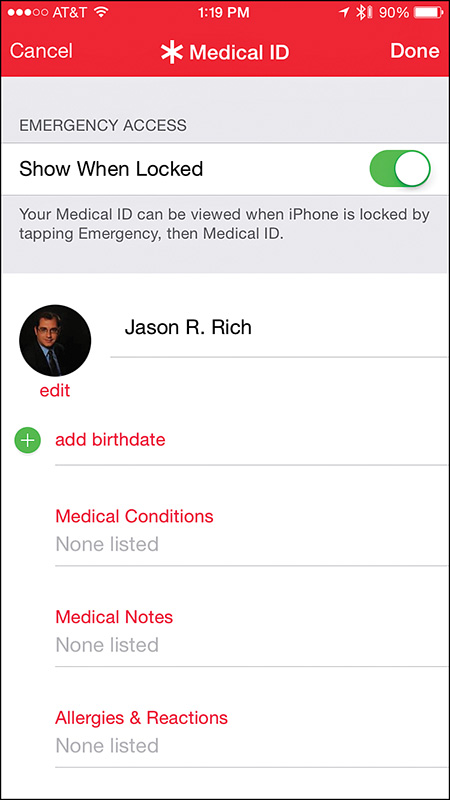10. Improve Your Health and Automate Your Home Using Your iOS Mobile Device
In This Chapter
![]() Get acquainted with iOS 8’s new Health app on the iPhone
Get acquainted with iOS 8’s new Health app on the iPhone
![]() Discover how the Health app works with other apps and equipment, including Apple Watch
Discover how the Health app works with other apps and equipment, including Apple Watch
![]() Learn how your iPhone or iPad can help you easily and inexpensively automate your home
Learn how your iPhone or iPad can help you easily and inexpensively automate your home
One of the things that’s built in to every iPhone and iPad model running iOS 8 is potential. In other words, what your smartphone or tablet is or will soon be capable of is limited only by the imaginations of app developers and your willingness to embrace cutting-edge new ways to utilize this technology in your everyday life.
Built in to iOS 8 are a vast assortment of tools available to app developers that now make it easier to create cutting-edge apps related to health, fitness, and home automation. As third-party developers begin to utilize these tools, and equipment manufacturers build iPhone compatibility and integration into their products, what will soon be possible using your smartphone or tablet are things that just a few years ago were only featured in science fiction novels, movies, and comic books.
Home automation refers to your ability to control other equipment in your home from your iPhone, such as the lights, a television set and cable box/DVR, door locks, thermostat, burglar alarm, security monitors, and even some major appliances.
Discover the New iPhone-Specific Health App
Among all the other app icons displayed on your iPhone’s Home screen is a new app called Health. On its own, the Health app can’t do much. However, for people who are fitness, health, and/or nutrition conscious, the Health app works as a “dashboard” with a growing number of other workout and fitness, diet, and lifestyle apps, and it can help you monitor and analyze your daily activity, food intake, and sleep patterns.
Beyond just working with other apps, the Health app is designed to integrate and communicate with optional equipment, such as the Apple Watch, as well as a vast selection of other fitness and medical devices, ranging from heart-rate monitors to workout machines, digital scales, and various types of sleep and blood sugar monitors. The Health app is designed to gather information from these sources and help you track your progress and share this data with appropriate professionals, when applicable.
The Health app comes preinstalled with iOS 8; however, as of Fall 2014, the potential of what this app will be able to do when used with other apps and equipment has barely been tapped. Apple is working closely with hospitals and medical equipment companies, fitness companies (including Nike), as well as many app developers to begin creating health, fitness, and diet tools for the iPhone that will make it easier for anyone to lead a healthier lifestyle.
What’s nice about the Health app is that it’s fully customizable. You determine what data it collects or what you enter into it, and then you determine how that data is used and whether it can be shared. If you ultimately choose to share certain information in the app, such as your fitness or workout progress with a personal trainer, you can still keep other medical data private.
![]() Tip
Tip
To discover what apps are designed to work with Health, visit the App Store, tap on the Explore icon that’s displayed near the bottom of the screen, and then tap on the Health & Fitness or Medical options.
Start Using the Health App Right Away
Without allowing your iPhone to communicate with other optional fitness or medical equipment, the Health app’s capabilities are limited to being a secure personal database for medical, diet, and health-related information that you manually enter into the app, or that can be imported from other apps installed on your iPhone.
To get started using the Health app, launch it from the Home screen. By default, the Dashboard screen is displayed. This is where collected data from optional apps and equipment is displayed in one centralized place. Using this data, you can easily track your health, fitness, diet and/or sleep patterns. Tap on the Day, Week, Month, or Year tabs that are displayed along the top of the screen to sort and display this information, if applicable.
![]() Note
Note
If you’re not using the Health app with other apps or optional equipment, a Dashboard Empty message is displayed near the center of the screen.
Displayed along the bottom of the screen are four command icons, labeled Dashboard, Health Data, Sources, and Medical ID. Tap on the Health Data icon to access a menu of categories related to the types of data the Health app is capable of collecting, tracking, analyzing, and sharing. As you can see from Figure 10.1, options include Body Measurements, Fitness, Me, Nutrition, Results, Sleep, and Vitals.
FIGURE 10.1 This is the main Health Data menu that’s displayed when you tap on the Health Data icon.
Tap on any of these options, and you can manually enter relevant data. For example, tap on the Me option to enter your Birthdate, Biological Sex, and Blood Type. Tap on Nutrition to manually track your intake of specific food types or the nutritional aspects of the food you eat. For example, from the Nutrition menu, tap on Caffeine, and then each time you consume a caffeinated beverage, tap on the Add Data Point option (shown in Figure 10.2).
FIGURE 10.2 You can manually track your intake of various types of foods or other nutrition-related information using the Health Data option built in to the Health app.
From the Add Data screen, the time and date are automatically recorded (however, you can tap on these fields to override them), and then you’re prompted to enter your consumption amount. As you do this over time, you can tap on the Day, Week, Month, or Year tabs displayed at the top of the Caffeine screen, for example, to display how much caffeine you consume and what times of day you’re most apt to consume it. As you tap on each tab, this information is also displayed in chart form on the screen.
As you’re tracking specific types of nutritional intake data, whether it’s caffeine, fiber, iron, potassium, sodium, sugar, or total fat, for example, turn on the virtual switch associated with the Show On Dashboard option (refer to Figure 10.2) to display this particular information on the app’s main Dashboard.
Tap on the Share Data option to specify exactly which apps and outside sources you’re willing to share this particular data with.
When it comes to selecting which apps and optional equipment you want to utilize with the Health app, this is controlled by tapping on the Sources icon. From here, you control which apps and equipment can transmit data to or retrieve data from the Health app. If no optional apps or equipment are being used, the word None is displayed under the Apps heading.
Every iPhone User Should Utilize the Health App’s Medical ID Feature
Whether or not you’re using any additional apps or equipment, you can utilize the Medical ID tool that’s built in to the Health app. This is basically a digital summary of vital medical information that you can make available to doctors, paramedics, or medical personnel in case of an emergency.
To use the Medical ID component of the Health app, tap on the Medical ID icon (in the lower-right corner of the screen). From the Medical ID welcome screen, tap on the Create Medical ID option, and then tap on each field to manually enter medical information about yourself (shown in Figure 10.3).
FIGURE 10.3 By filling in the Medical ID component of the Health app with your personal data, it can later be accessed by medical professionals in an emergency situation.
Here, you can list your medical conditions, emergency contacts, primary care physician, your birthday (age), height, weight, blood type, and whether you want to be an organ donor. For easy identification, you can also include a photo of yourself in the app.
![]() Tip
Tip
After filling in these fields with your personal data, it’s possible to later edit it by tapping on the Edit icon that’s displayed in the top-right corner of the screen.
At the top of this Medical ID Edit Screen is a virtual switch associated with the Show When Locked option. Turn on this option if you want a doctor or emergency medical professional to be able to access your Medical ID information from your locked iPhone, without knowing its passcode.
![]() Tip
Tip
Tap on the Medical ID Edit option to reveal additional fields that you can manually fill in. The more information you include, the more helpful it could be to doctors in an emergency situation. For example, be sure to fill in the Medical Notes and Allergies & Reactions fields, as well as the Medications field with an up-to-date listing of medications you take.
Fitness Trackers Can Also Communicate with the Health App
In addition to the Apple Watch being designed to work seamlessly with the Health app on the iPhone to gather fitness-related data and transmit it wirelessly and in real time, several third-party fitness trackers are available. For example, there’s the popular Nike+ FuelBand SE (www.nike.com/FuelBand); several products from Fitbit (www.fitbit.com), including the Fitbit Flex, Fitbit Ultra, Tory Burch ring, and the Metal Fret Pendant; and Jawbone’s Up24 fitness and sleep tracker bracelet (https://jawbone.com/up). Each of these products works with a proprietary iPhone app as well as the Health app.
![]() Note
Note
Many of the third-party fitness tracker accessories offer similar fitness-related functionality to what the Apple Watch offers, but these devices are typically priced at less than $150.00, compared to the starting price of Apple Watch, which is $349.00.
Other companies offer more high-tech medical devices that work with the iPhone (and Health app). For example, there’s the iBGStar Glucose Meter (www.ibgstar.us), iPhoneECG Electrocardiogram from AliveCor (www.alivecor.com), and the Withings Blood Pressure Monitor (www.withings.com/us/blood-pressure-monitor.html).
Home Automation is Easy Using Your iPhone/iPad
Built in to iOS 8 are tools that Apple refers to as HomeKit. As an iPhone or iPad user, this is not something you have direct access to, because they’re tools designed for use by app developers and companies that manufacture home automation-related products that can be controlled wirelessly using an iPhone or iPad.
In the last few years, dozens of companies have released cutting-edge products related to home automation that are affordable and extremely easy to use. Some of the most successful home automation products released thus far include the Philips Hue Lighting System (www.meethue.com), NEST thermostat (www.nest.com), and the Kevo Kwikset automated door lock (www.kwikset.com).
In addition, every major home security company, including ADT (www.adt.com) and Xfinity Home Security (www.comcast.com/home-security.html), has introduced complete systems that can be remotely controlled from an iPhone. These systems enable you to control the burglar alarms, smoke detectors, door locks, lights, and the garage door opener, for example.
There are also many inexpensive do-it-yourself home security and monitoring tools that don’t require an ongoing monthly fee. For example, for about $100.00, you can purchase a wireless camera that can be used for home security (or as a baby/pet monitor). It can be plugged in anywhere in your home, and then will transmit live video and sound directly to your iPhone, which you can view from anywhere in the world. For these cameras to work, an in-home wireless network is required, plus your iPhone requires Internet access.
Most cable and satellite TV companies and DVR (digital video recorder) makers, including TiVo, have also developed proprietary apps that allow iPhone (or iPad) users to remotely program and control their home theater system from virtually anywhere, and in some cases, stream content that’s saved on a DVR directly to an iPhone or iPad’s screen for remote viewing.
Meanwhile, a company called Belkin (www.belkin.com) has been a pioneer in the iPhone/iPad home automation arena. This company offers a lineup of WeMo products that include the WeMo Insight Switch electrical outlet and WeMo Light Switch.
The Insight Switch plugs into any existing electrical outlet, and then using a special app, enables users to remotely turn on or off what’s plugged into that outlet using their iPhone or iPad, while the WeMo Light Switch replaces any traditional light switch with one that can also be remotely controlled from a smartphone or tablet.
Belkin has also introduced the WeMo LED Starter Kit to compete with Philips Hue Lighting System and provide consumers with an easy to way install and use programmable LED lights within a home or office. Plus, the company has given Crock-Pot cooking a high-tech twist with the Crock-Pot Smart Slow Cooker with WeMo, which allows for this Crock-Pot to be remotely programmed and controlled from anywhere using an iPhone or iPad.
In the near future, more categories of home automation products will be made available. One of the more interesting categories are smart appliances, such as refrigerators, washers, and dryers, that will be controllable from an iOS mobile device. Imagine being at a supermarket, tapping on your iPhone’s screen, and being able to determine whether you need to add milk to your shopping list based on what’s currently in your fridge.
Thanks to Apple’s HomeKit tools that app developers are now working with, home automation apps will become compatible with Siri, so they’ll accept voice commands and requests to remotely control various products and devices from an iPhone or iPad.
Plus, security features that utilize the TouchID sensor that’s built in to the Home button of the iOS mobile devices could be used in addition to passwords to keep unauthorized people from remotely accessing or controlling various home automation products being used in your home.
How these HomeKit tools will be implemented by the various home automation companies and app developers is yet to be seen. However, Apple has developed these tools to enhance security-related tasks associated with home automation, and at the same time, has issued some strict guidelines in terms of how these technologies can be used to provide home automation services without infringing on a consumer’s privacy.



